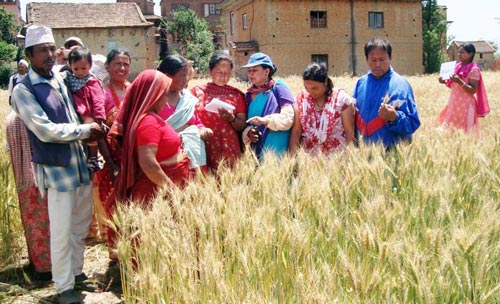 On 14 May 2012, at Tikathali, Changathali Village Development Committee Centre (VDC) in Lalitpur, around 30 participants from MoA, NARC, seed companies, and CIMMYT were joined by 61 farmers (43 female, 18 male) and several graduate students and technicians. The event also saw active participation from senior district agriculture development officers from Lalitpur, Bhaktapur, and Kathmandu as well as the Crop Development Directorate of Nepal and the Seed Quality Control Center.
On 14 May 2012, at Tikathali, Changathali Village Development Committee Centre (VDC) in Lalitpur, around 30 participants from MoA, NARC, seed companies, and CIMMYT were joined by 61 farmers (43 female, 18 male) and several graduate students and technicians. The event also saw active participation from senior district agriculture development officers from Lalitpur, Bhaktapur, and Kathmandu as well as the Crop Development Directorate of Nepal and the Seed Quality Control Center.
After a brief introduction, the farmers were led on a field tour by Maiya Maharjan Saligram, the head of the Loktantrik Integrated Pest Management Group in Changathali. Here they were shown the wheat plots and given detailed information about the characteristics of each variety, such as maturity class, yield potential, and disease resistance.They were split into four groups and asked to evaluate six varieties and two checks, which they then ranked one to eight according to individual performance.
Back at the VDC, NARC’s senior plant pathologist Sarala Sharma said that with active awareness among farmers, wheat breeders, and pathologists, Nepal is fully prepared to face the possible arrival of the stem rust race Ug99 because resistant varieties are already in farmers’ fields. She also described how positive the PVS approach has been over recent years; not only has there been a rapid increase in adoption rates of new varieties, but there has also been a remarkable reduction in yellow rust. Madan Bhatta, chief of NARC’s germplasm division, also endorsed the PVS approach, while Dilaram Bhandari from Seed Quality Control suggested that small-scale farmers should work together to develop an effective seed producers organization. The farmers were further encouraged by Suroj Pokhrel, director of the Crop Development Directorate, and Yubak Dhoj G.C. from the Plant Protection Directorate, who assured them that their suggestions are extremely important.
The farmers themselves were very happy with the event, saying that by sharing experiences with each other, they were building confidence in their own ability to manage wheat diseases, seed production, and profitability. They were particularly enthusiastic about strengthening their groups to share new technology and seed varieties, with the female farmers especially motivated. Through PVS, farmers have widened the coverage of rust resistant varieties, tested new options, and gradually replaced older, lower-yielding varieties, thus increasing production and productivity. With the new varieties, the farmers expected a 10% yield increase.
Other participants included Hira Kaji Manandhar from the plant pathology division at the National Agriculture Research Institute (NARI) of NARC, NARC scientist D.B. Thapa; NARC crops and horticulture director Yagya Prasad Giri; CIMMYT’s regional wheat breeder Arun Joshi; and lead farmer Dhana Maharjan.
 Capacity development
Capacity development 
